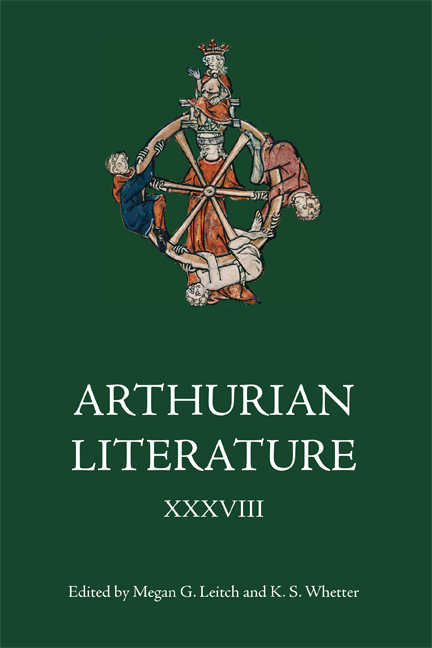Book contents
- Frontmatter
- Contents
- List of Figures and Tables
- Note on the Derek Brewer Prize
- General Editors’ Preface
- List of Contributors
- List of Abbreviations
- 1 The Inaugural Derek Brewer Essay Prize: Animals at the Feast: Strange Strangers and Courtly Power in The Wedding of Sir Gawain and Dame Ragnelle
- 2 The Kindred of a Boy without a Father: Merlin’s British Forebears and Irish Cousins
- 3 Geoffrey of Monmouth’s Subtle Subversion: Active Double- Voiced Discourse in the Historia regum Britanniae
- 4 ‘Cornwall, up in the North’: Geography and Place Names in the Source of the Old Icelandic Brut
- 5 Enacting Arthurianism in the Order of the Garter and Sir Gawain and the Green Knight
- 6 Deviants and Dissenters: Theorizing Shame and Punishment in Malory’s Morte
- 7 Loyalty and Worshyp in Conflict in Malory’s Lancelot
- 8 Emotional Inheritance in Malory’s Morte Darthur: Shame and the Lott–Pellinore Feud
- 9 Navigating and Indexing Arthurian Romance in Benoît Rigaud’s Edition of Lancelot du Lake (1591)
- 10 ‘A great many strange puppets’: Queen Caroline, Merlin’s Cave, and Symbolic Arthurianism in the Age of Reason
- 11 How Galahad Regained his Virginity: Dead Women, Catholicism and the Grail in Nineteenth-Century British Poetry
- Notes
- Miscellaneous Endmatter
13 - Malory and the Book of St Albans
Published online by Cambridge University Press: 10 January 2024
- Frontmatter
- Contents
- List of Figures and Tables
- Note on the Derek Brewer Prize
- General Editors’ Preface
- List of Contributors
- List of Abbreviations
- 1 The Inaugural Derek Brewer Essay Prize: Animals at the Feast: Strange Strangers and Courtly Power in The Wedding of Sir Gawain and Dame Ragnelle
- 2 The Kindred of a Boy without a Father: Merlin’s British Forebears and Irish Cousins
- 3 Geoffrey of Monmouth’s Subtle Subversion: Active Double- Voiced Discourse in the Historia regum Britanniae
- 4 ‘Cornwall, up in the North’: Geography and Place Names in the Source of the Old Icelandic Brut
- 5 Enacting Arthurianism in the Order of the Garter and Sir Gawain and the Green Knight
- 6 Deviants and Dissenters: Theorizing Shame and Punishment in Malory’s Morte
- 7 Loyalty and Worshyp in Conflict in Malory’s Lancelot
- 8 Emotional Inheritance in Malory’s Morte Darthur: Shame and the Lott–Pellinore Feud
- 9 Navigating and Indexing Arthurian Romance in Benoît Rigaud’s Edition of Lancelot du Lake (1591)
- 10 ‘A great many strange puppets’: Queen Caroline, Merlin’s Cave, and Symbolic Arthurianism in the Age of Reason
- 11 How Galahad Regained his Virginity: Dead Women, Catholicism and the Grail in Nineteenth-Century British Poetry
- Notes
- Miscellaneous Endmatter
Summary
Pre-modern people referred to books differently. Three of the earliest and most important Welsh books, for instance, are named not from their contents but from the colour of their original bindings: The Black Book, The Red Book and The White Book. The two best-known medieval English authors offer a revealing contrast in the way they refer to books.
Surprisingly, the earlier of them, Geoffrey Chaucer, is much the more modern. He names many authors and books, and the way he names them makes a small difference to the nature of his fictional worlds. This can be shown just from those authors and books whose names begin with A. They do not include the major source for any of Chaucer's individual works, the first of which appears with B, which supplies Bocace, Boece and the Bretons (or are they Britons?) who may have provided the Wife of Bath with her Arthurian story. Nevertheless, the letter A supplies an abundance of authors and books.
As narrator, Chaucer speaks in one of his dream poems of a crowd so large that measuring it would be a challenge for Argus (not the hundred-eyed watchman of Greek mythology but the ninth-century Arab mathematician Abu Abdallah Muhammad ibn Musa), in another dream poem he says he is imitating Alanus's Pleynt of Kynde (Alanus de Insulis's De Planctu Naturae), and in a third he repeats an opinion from the same Alanus's Anticlaudianus and names Aristotle as a typical philosopher and Atiteris (Tityrus, from Vergil's First Eclogue) as a typical poet: BD 435–42, PF 316–8, HF 986, 759, 1227. Elsewhere he refers his audience for a fuller version of a story to the Argonautycon (Gaius Valerius Flaccus's Argonautica): LGW 1457. In well-known passages in the General Prologue, he evokes one character's knowledge of Avycen and Averrois (the eleventhand twelfth-century Arab physicians Avicenna and Averroes) and another's yearning for twenty books of Aristotle; and in one of the Tales he refers to discussions of optics by Aristotle and Alocen (the tenth-century Arab scientist Alhazen, alias Ibn al-Haitham): GP 432, 433, 295, SqT 228–35. In another work he explains how to use the astronomical tables compiled by Arsechiel (the eleventh-century Arab astronomer Ibn al Zarqali): Astr 2.45.2.
- Type
- Chapter
- Information
- Arthurian Literature XXXVIII , pp. 313 - 324Publisher: Boydell & BrewerPrint publication year: 2023

